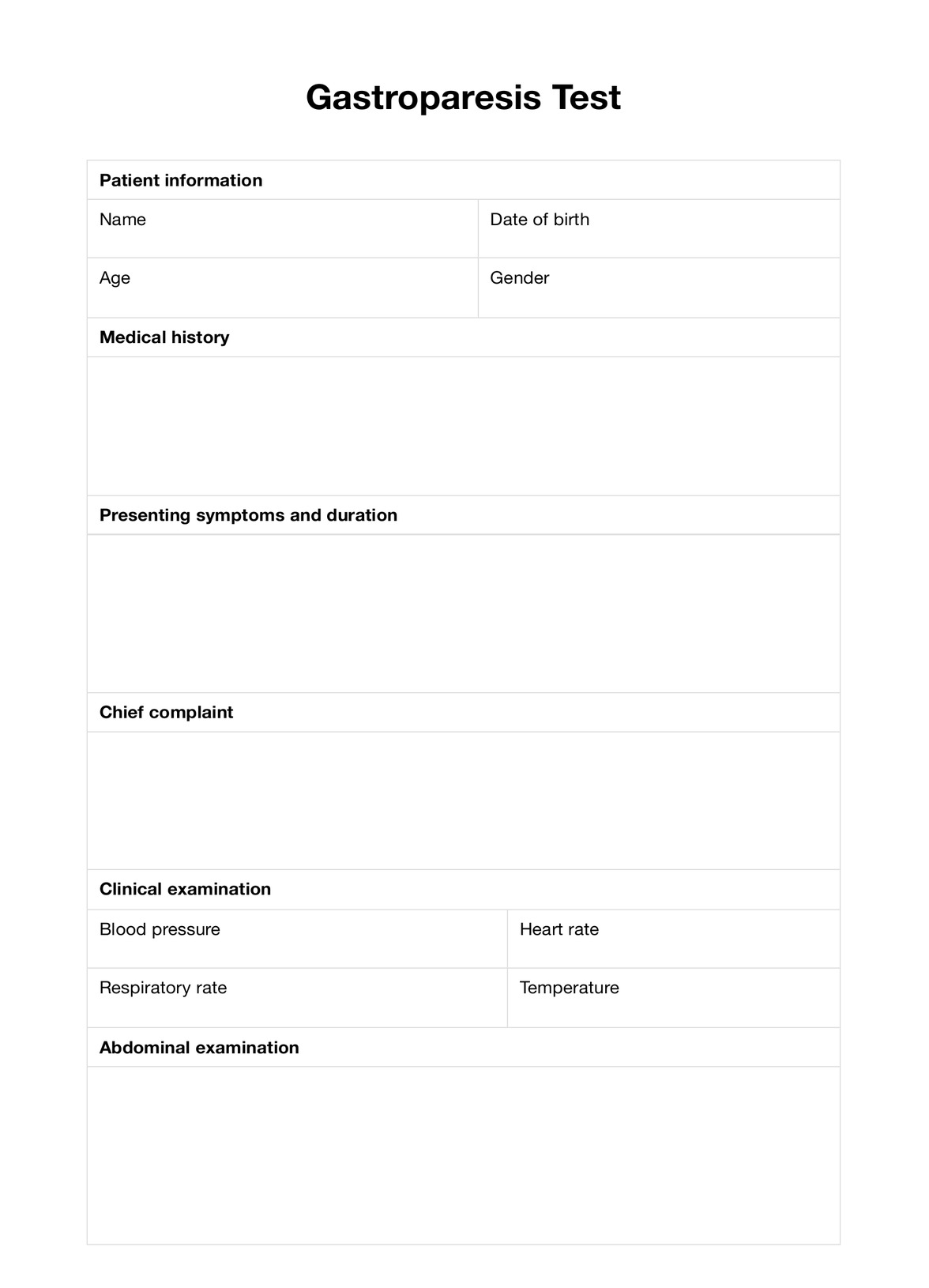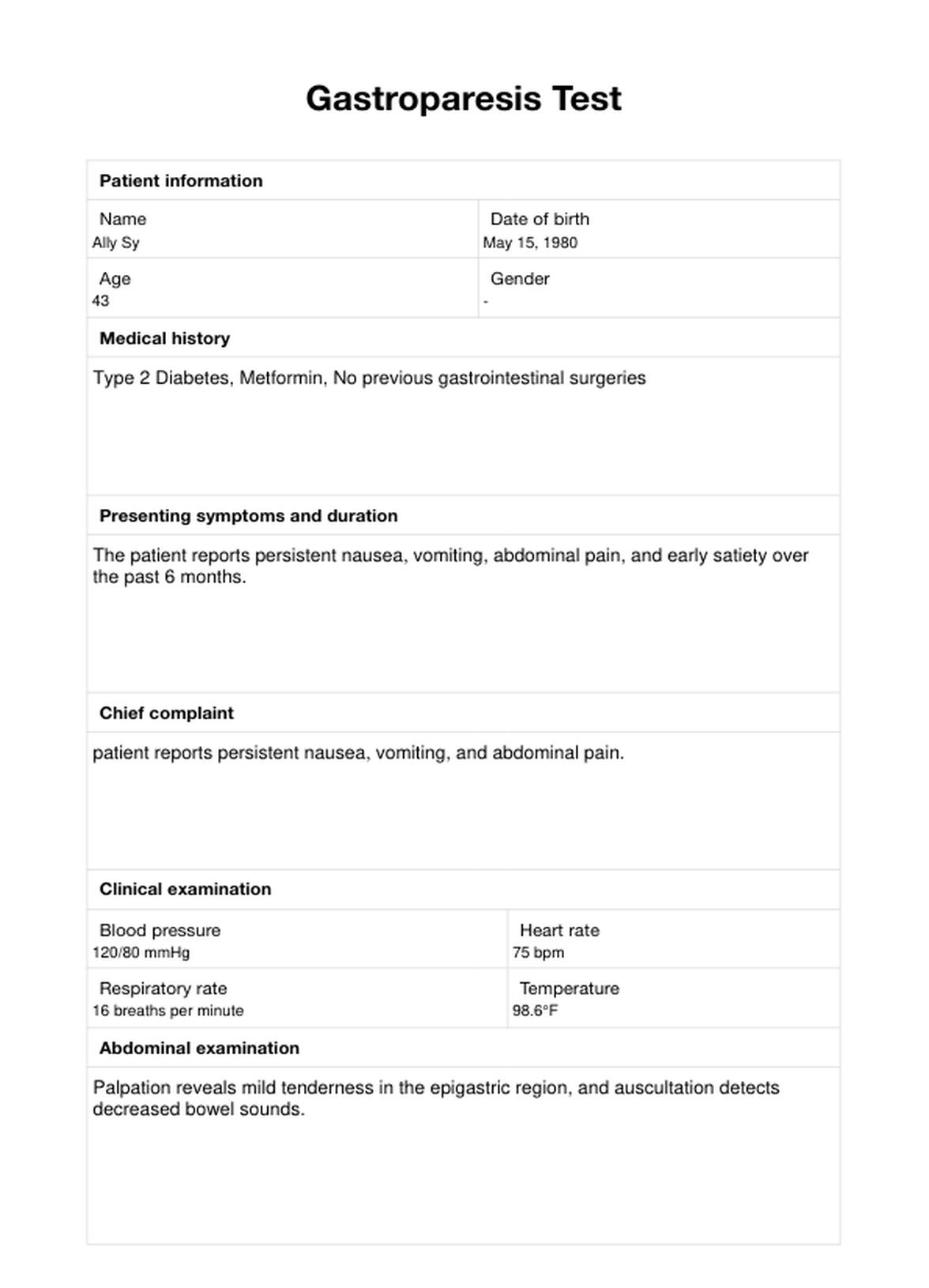Gastroparesis Test
Learn gastroparesis and how to streamline your test documentation. Download a free PDF template and example here.


What is gastroparesis?
Gastroparesis, or delayed gastric emptying, is a complex and challenging condition that affects the normal movement of the muscles in the stomach, leading to delayed emptying of food into the small intestine or the upper digestive system. Various factors, such as nerve damage, hormonal imbalances, or certain medications, can cause this.
The symptoms of gastroparesis can vary from person to person but commonly include nausea, vomiting, bloating, and abdominal pain. These symptoms can be debilitating and significantly impact a person's quality of life (Mayo Clinic, n.d.).
One of the most prevalent symptoms is feeling fullness quickly after eating, even with a small amount of food (National Institute of Diabetes and Digestive and Kidney Diseases, n.d.). This is known as early satiety and can be frustrating for individuals with this condition. In addition, heartburn, acid reflux, and a lack of appetite are other symptoms that may arise.
Managing gastroparesis can be challenging and often involves dietary modifications, medication management, and lifestyle changes. Healthcare professionals may also recommend a gastroparesis test to diagnose and monitor the condition.
Gastroparesis Test Template
Gastroparesis Test Example
Common causes of gastroparesis
Gastroparesis can be caused by a variety of factors, such as (Mayo Clinic, n.d.; National Institute of Diabetes and Digestive and Kidney Diseases, n.d.):
Diabetes
High blood sugar levels and hyperglycemia can harm the body. One of these effects is the potential damage to the nerves responsible for controlling the muscles in the stomach.
Surgery
Procedures involving the upper gastrointestinal tract can result in nerve damage or scarring, disrupting stomach motility.
Medications
Certain medications, including opioids, antidepressants, and certain blood pressure medications, can have an impact on the muscles in the stomach. This can lead to symptoms such as slowed digestion, constipation, or even gastrointestinal motility disorders.
Infection
Viral infections like the Epstein-Barr or cytomegalovirus can damage nerve tissue and interfere with stomach muscle function. This can lead to gastroparesis symptoms.
Neurological disorders
Conditions that affect the nervous system, such as Parkinson's disease or multiple sclerosis, can cause gastroparesis by damaging the nerves responsible for stomach movement.
Autoimmune disorders
Conditions like scleroderma or lupus can damage the nerves and muscles in the stomach. This can result in gastroparesis symptoms.
Eating disorders
Individuals who have a history of eating disorders, particularly anorexia nervosa, are at a higher risk for developing gastroparesis. This is because bulimia and anorexia can disrupt the normal functioning of the stomach muscles.
Gastroparesis symptoms
As mentioned earlier, symptoms can vary from person to person and may include (Mayo Clinic, n.d.; National Institute of Diabetes and Digestive and Kidney Diseases, n.d.):
- Nausea and vomiting
- Bloating
- Abdominal pain
- Feeling full quickly after eating (early satiety)
- Lack of appetite
- Heartburn or acid reflux
- Fluctuations in blood sugar levels (for individuals with diabetes)
Evaluating and diagnosis gastroparesis
Healthcare professionals usually conduct various tests to diagnose gastroparesis. Some of these tests are:
Gastric emptying test
This gastric emptying scan test or gastric emptying scintigraphy involves eating a meal that contains a small amount of radioactive material and tracking the movement of food through the digestive system using a special camera. A delayed emptying time is often indicative of gastroparesis.
Upper endoscopy
This procedure uses a thin, flexible tube with a camera on the end to examine the inside of the stomach and check for any abnormalities or blockages.
Upper gastrointestinal (GI) series
A series of X-rays are taken after drinking a contrast dye, which can show any abnormalities in the stomach's shape or function.
Endoscopy
A thin, flexible tube with a camera on the end is inserted through the mouth to view the stomach's lining and look for any damage or inflammation.
Electrogastrography
This test measures the electrical activity of the stomach muscles to determine how well they are functioning.
Gastric emptying breath test
A patient drinks glucose or lactose solution and exhales every 15 minutes for up to two hours. The breath is tested for hydrogen and methane, indicating how quickly the stomach empties.
Blood and imaging tests may also rule out other conditions and determine the cause of gastroparesis. Healthcare professionals may also conduct a physical exam and review the patient's medical history.
How to use Carepatron's Gastroparesis Test template
Carepatron's free Gastroparesis Test template helps you document your patient's symptoms, track their test results, and monitor their progress over time. Follow these steps:
Step 1: Download the template
Get a copy of the free Gastroparesis Test form using the link below or the Carepatron app. You can also get it from our resources library.
Step 2: Print or use the digital format
The template is available in both printable and digital formats. Choose the option that works best for you.
Step 3: Use the form to document the test
Begin by filling out the patient's personal and medical information at the top of the form. Then, document their symptoms using the provided section. Next, record any test results or diagnoses.
Step 4: Track progress
Use additional sections to track any changes in symptoms or test results over time. This can help you and your patient see progress and make informed decisions about treatment options.
Step 5: Share with the healthcare team
The template is designed to be shared with other healthcare team members, such as specialists or primary care physicians. This allows for better communication and coordination of care for the patient.
Step 6: Save for future reference
Save a digital copy of the completed form for future reference. This can help track progress over time or provide documentation for insurance purposes.
Gastroparesis treatment options
While there is no cure for gastroparesis, there are options to treat gastroparesis available. These may help manage symptoms and improve quality of life (Cleveland Clinic, n.d.):
- Changes in diet: Some patients may benefit from a low-fat, low-fiber diet. Smaller and more frequent meals may also be helpful.
- Medications: Depending on the underlying cause of gastroparesis, drugs such as prokinetic agents or antiemetics may be prescribed to help with symptoms.
- Feeding tube: ** In severe cases, a feeding tube may be necessary to provide nutrition and hydration.
- Gastric electrical stimulation: This is a procedure where a device is surgically implanted to help stimulate the stomach muscles, improving motility.
- Surgery: In rare cases, surgery may be recommended to remove any blockages or scar tissue in the stomach.
Managing gastroparesis
Patients with gastroparesis may experience flare-ups of symptoms, so it is essential to have a plan in place for managing these episodes. This may include:
Keeping track of symptoms
Patients can use a symptom diary or journal to track their symptoms, including the type and severity of symptoms and any triggers or patterns.
Making dietary adjustments
During flare-ups, it may be necessary to make temporary changes to the diet, such as sticking to only easily digestible foods and avoiding high-fat or high-fiber foods.
Following medication regimen
If prescribed medications, it is essential to follow the recommended regimen as directed by a doctor. This may include taking medicines before or after meals, depending on the type of medication.
Seeking medical attention
Sometimes, flare-ups may be too severe to manage at home and require immediate medical attention. Patients should have a plan in place for when to seek medical help.
References
Cleveland Clinic. (n.d.). Gastroparesis. https://my.clevelandclinic.org/health/diseases/15522-gastroparesis
Mayo Clinic. (n.d.). Gastroparesis - Symptoms and Causes. https://www.mayoclinic.org/diseases-conditions/gastroparesis/symptoms-causes/syc-20355787
National Institute of Diabetes and Digestive and Kidney Diseases. (n.d.). Symptoms & Causes of Gastroparesis. https://www.niddk.nih.gov/health-information/digestive-diseases/gastroparesis/symptoms-causes
Commonly asked questions
Delayed gastric emptying, commonly known as gastroparesis, is when the stomach takes longer than usual to empty its contents. It often disrupts the upper digestive system's function, leading to symptoms like nausea, vomiting, and fullness after eating small amounts.
The condition impairs the normal movement of food from the stomach to the small intestine, leading to various issues, such as malnutrition, unpredictable blood sugar levels, and the development of bezoars.
Gastritis is inflammation of the stomach lining, while gastroparesis is a condition that affects the movement and emptying of the stomach. While gastritis can cause nausea and vomiting, it does not directly affect gastric emptying like gastroparesis.














































































































